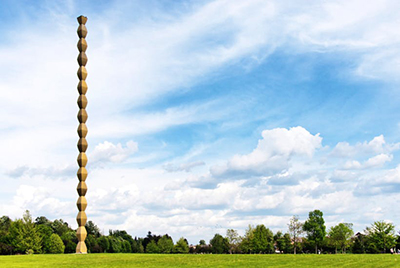This sculpture by Constantin Brancusi is the earliest extant of the Endless Column. In the earlier years, the artist had majorly made use of the single or double pyramid to create the base of his sculptures. However, time saw him realise that these abstract creations were realised works on their own right.
He carved the Endless Column sculpture out of oak, creating a visually appealing succession of pyramids. These repetitive pyramids created an impressive undulating and rhythmic geometry, a clear indication of the possibility of infinite expansion. This piece was very appealing to him and that is why he created a similar sculpture for his friend Edward Steichen in the mid-1920s and erected a similar column in Tirgu-Jiu in Romania. This Romanian column was an impressive 98 feet in height. Other collections in the last ensemble of the Endless Column were Table of Silence and The Gate of the Kiss. These columns were Brancusi's persistent and strong affinity for the mythical, cosmic and sacred. This idea of infinite expansion was intricately brought out by the repetitive technique Brancusi used by the use of the rhomboid shapes that were identical in nature.
The elevation of the column of the sculpture consists of 15 rhomboid beads that are identical in nature that is then flanked by modules that create a spectacular optical illusion at either side of the column. That is why a look at the column and you might e=be made to think that they are actually intertwined and ascending into infinity. The underlying meaning is the ascension into heaven of the souls of soldiers because Brancusi believed in the sustenance of the vault of heaven. The pedestals at the base of the columns were an interesting artistic approach that Brancusi chose to take that later sparked a lot of discussions as to whether the bases of sculptures were part of the art.
The use of pedestals by Brancusi was revolutionary and his contemporaries subscribed to his line of thought, especially regarding the pedestals the base of his creations. He interestingly bestowed so much importance at the base of his artworks. Such radical imaginations and interesting way of looking at things went a long way in influencing and inspiring other artists, not only in his time but to modern sculptors too. Some notable names include Donald Judd, Isamu Noguchi, and Richard Serra plus some of his friends including Ezra Pound and the Art deco movement. He was also largely influenced by some of his friends like Alfred Stieglitz, Henri Rousseau, and movements like Dada. Artists who head a great bearing in his artistic styles included the likes of Auguste Rodin and Fernand Leger.




